#punjabi chola
Explore tagged Tumblr posts
Text
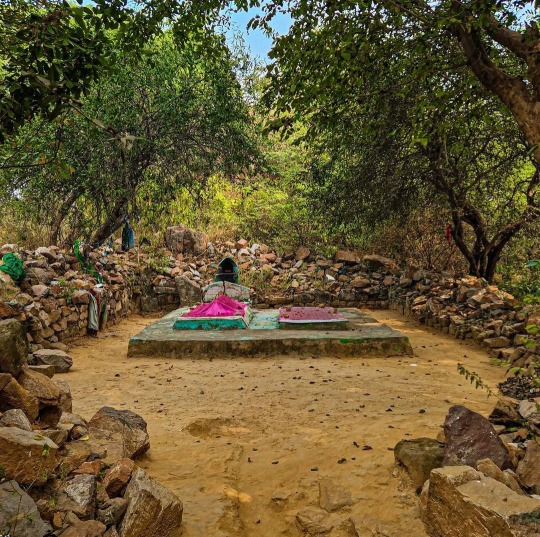
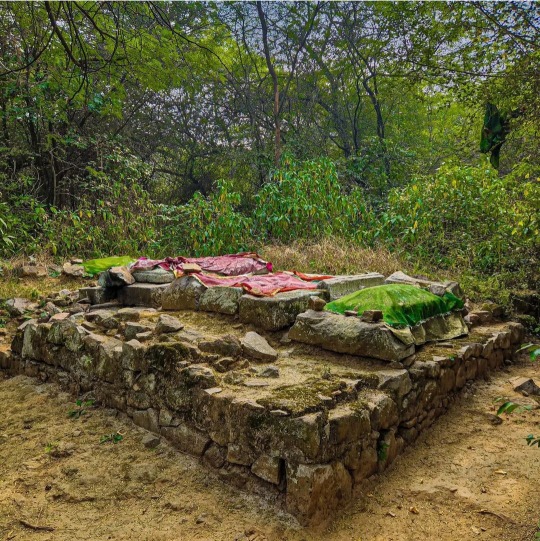

The oldest Sufi shrine in Delhi has been demolished.
"The earliest Sufi Shrine in Delhi - belonging to a relative of Prithviraj Chauhan and dating from BEFORE the Turkish conquest - has been Demolished by the Delhi Development Authority in an "anti encroachment" drive.
In the late 12th century, a group of Afghan pastoralists, suddenly burst onto the world stage. In a matter of years, they toppled their rulers of Ghazni and seized major Persian cities like Herat, and then established the major Indian sultanate in Delhi.
We often think of this "Islamic invasion" as the start of the Muslim presence in India. Yet recent scholarship has shown that by the time of Ghori's conquest of Delhi, Muslims were already a central part of Indian society
Some of the earliest mosques are found in Kerala, dating from a few decades after the prophet Muhammad's death. Tamil Pallava, Chola and Pandya kings all built sizeable mosques
Delhi also had a single sufi shrine before the Afghan conquest - this one.
Until 31 January, when it was demolished, the shrine of Baba Haji Rozbih had been located by the Fateh Burj, or Victory Gate of Lal Kot. The grave next to it under a reddish Chador belongs to his female disciple Bibi. Bibi was said to be a close relative of Prithviraj Chauhan who embraced Islam under the aegis of Haji Rozbih.
This demolition is an UTTERLY MINDLESS LOSS and complete cultural desecration.
What's more the "anti encroachment" drive is apparently scheduled to include the Aashiq Allah Dargah dated to 1317AD which is where the great Punjabi Saint Baba Farid used to meditate, and his small 'chillagah' is still visible here.
Please do share and write about this so we can save what remains! "
- from the historian Sam Dalrymple .
...
This is the third Islamic structure to be demolished in Delhi this month. Isn't it funny how only certain structures are the victim of anti- encroachment drives? This is part of a planned programme by the current right-wing government of India that is violently islamophobic and wants to create a hindu ethnostate modeled after Israel.
#india#desi tumblr#desiblr#south asia#punjab#sufi#sufism#islam#delhi#new delhi#anti-hindutva#anti-bjp#islamophobia#anti hindutva#anti bjp
167 notes
·
View notes
Text
What is Tiffin?
What is Tiffin? A tiffin is a lunch box that holds a variety of foods. Tiffins are typically made of stainless steel, which helps keep the food hot or cold. It also contains a handle for easy carrying.
Tiffins are not made to be used on the stove or in a hot oven, as the heat can warp them. Our tiffins are made of food-grade, non-leaching stainless steel and are BPA- and phthalate-free. Many peoples are searching for Indian tiffin near me on Google.
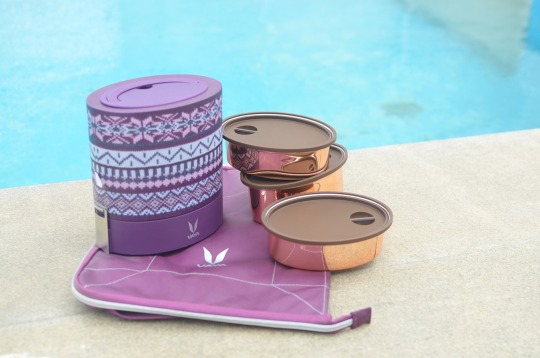
In South India, tiffin means a light snack between breakfast and dinner or a tea-time meal at about 3 pm consisting of typical tea-time snacks like cutlets, idlis or vadas.
Outside of South India, the word tiffin mostly refers to any packed meal or snack and is sometimes a name for the food carrier itself: tiered stainless-steel containers with lids that can be locked together and clamped down on the sides or top.
The containers were originally made of brass but are now often aluminium or stainless steel and can be found in any size from tiny to gargantuan. In the UK, Many peoples searching tiffin service near me on Google.
On any weekday in Bombay (now Mumbai), tiffins, or dabbas, can be seen stacked up on handcarts or bicycles being pushed along the busy streets by dhoti-clad men called tiffin wallahs, or dabbawalas.
These workers operate a complex system to ensure that thousands of tiffins are delivered daily to their intended recipients, often office workers. You can get food delivery Slough, UK.
Tiffin service is the perfect option if you want to enjoy home-cooked meals without having to cook. Quickly offers a huge selection of Indian tiffins in Manhattan, delivered right to your doorstep.
What is Punjabi food?
Are you looking for Punjabi food near me in the UK? Even non-vegetarians will yield to their cravings when it comes to Punjabi cuisine. From appetizers like Chola Bhatura and bread pakoras to dinner items like Sarson da saag and Makki di roti, the food of this region is a delight for every palate.
What is the Mildest Indian Curry?
Ever looked at a curry menu at an Indian restaurant and not sure which dish is mild? Or even medium spiced? Some popular mild Indian dishes include butter chicken, tikka masala, dal makhani, and chana masala.
Don’t worry; there are plenty of options out there. From the classic Korma to the north Indian Pasanda (as seen above), here are a few of our favourite dishes that are perfect for those with a low spice tolerance.
What is a Balti Curry?
What is a balti curry? A balti is a curry that comes with lots of vegetables, and it is loose in texture and quite tangy. It is the ideal curry for vegetarians as meat usually takes a back seat.
It is a very popular curry in the UK, particularly in Birmingham, known as ‘the balti triangle’. It is normally served with naan bread to mop up all that delicious sauce!
Indian Home Cooked Food Delivery In the UK
Are you looking for the best Indian Home Cooked Food Delivery Near Me? We are all about serving honest, home-cooked, good food. Our meals are delivered in tiffin boxes (more like milk pails) and are chilled so that they can be eaten cold or heated up later when you are ready to eat.
What is Desi?
People with the name Desi are believed to be creative, independent, and spiritual. While a person’s personality traits may not be entirely determined by their birth name, they do play an important role in identity formation.
What is Desi Meaning? Desi is a term that describes someone with Indian, Pakistani, or Bangladeshi heritage. It isn’t a derogatory phrase and can be used to describe both men and women.
#What Is Tiffin#Tiffin#Tiffin Service#Tiffin Meals#Tiffin Box#tiffin service near me#indian tiffin services near me#indian tiffin near me#lunch tiffin box#indian lunch box#what are tiffins
2 notes
·
View notes
Text
Why South India is different from North India?
South India and North India are different from each other in terms of their geography, culture, history, and language. Here are some of the main differences between the two regions:
Geography: South India is characterized by its tropical climate, lush greenery, and numerous rivers and backwaters, while North India is characterized by its arid climate, rugged terrain, and the Himalayas in the north.
Culture: South India has a distinct culture that is influenced by the Dravidian heritage, which is reflected in its art, music, dance, and literature. In contrast, North India has a culture that is more influenced by the Indo-Aryan heritage, which is reflected in its music, dance, and literature.
History: South India has a long and rich history dating back to ancient times. The region was home to many powerful dynasties, such as the Cholas, Cheras, and Pallavas, who left behind a rich legacy of art and architecture. In contrast, North India was home to many powerful empires, such as the Mauryas, Guptas, and Mughals, who left behind a rich legacy of art, architecture, and literature. indian dating app - vinita
Language: South India has its own set of languages, including Tamil, Telugu, Kannada, and Malayalam, while North India has Hindi as its main language, along with many other regional languages like Punjabi, Bengali, and Gujarati.
Cuisine: South Indian cuisine is characterized by its spicy and tangy flavors, with rice and lentils forming the staple diet, while North Indian cuisine is characterized by its rich and creamy gravies, with bread and meat forming the staple diet.
Overall, South India and North India are two distinct regions with their own unique characteristics, and the differences between the two regions make India a diverse and fascinating country.
4 notes
·
View notes
Text
How Indian Jewellery Reflects Regional Diversity and Traditions

Introduction
Indian jewellery is more than just a fashion statement; it is a reflection of culture, heritage, and artistry. Across India's wide width, each region has its own particular styles, materials, and techniques that reflect its rich diversity. From the complex artistry of Kundan jewellery in Rajasthan to the delicate filigree motifs of Odisha, Indian jewellery reflects the country's distinct traditions and customs. Here's how Indian jewelry reflects the region's diversity and centuries-old traditions.
1. Rajasthan: Land of Kundan and Meenakari.
In Rajasthan, Indian jewellery is distinguished for its splendor and majesty. The state is famed for Kundan jewelry, a traditional type of gemstone setting in which gemstones are set in gold using a foil. technique. Meenakari, the skill of enameling jewelry, is another example of Rajasthani workmanship. The elaborate designs, which frequently feature flowers, birds, and peacocks, are notable for their brilliant colors and superb detailing. Rajasthani jewellery is commonly worn during weddings and royal festivities, representing prosperity and good fortune.
2. South India: temple jewellery and filigree work.
Southern India is home to some of the most ancient and prominent jewellery traditions. Temple jewelry, which dates back to the Chola empire, is a popular style that is both religious and creative. This form of jewellery, intricately created with deity and mythological creature motifs, is commonly worn by temple dancers and during temple festivities. Gold jewelry is prevalent in South India, and its beautiful filigree work can be Found in items such as Vanki (armlets) and Vaddanam (waistbands), which are frequently part of a bride's trousseau.
3. Bengal: Timeless Elegance of Gold.
Bengali jewellery is noted for its timeless elegance, with gold as the principal material. Traditional Bengali jewelry consists of Tangla (a broad necklace), Shankha (bangles made of conch shell), and Latkan (hanging ornaments). These garments are traditionally worn at festivals and weddings and are strongly ingrained in Bengali women's culture and identity. Bengali jewellery also features floral themes and religious symbols that represent beauty, grace, and reverence.
4. Maharashtra: Paithani and Kolhapuri Jewellery.
Jewellery from Maharashtra illustrates the state's historical association with royalty and agrarian society. The Paithani saree, with its gold-encrusted pallu, is complemented by magnificent gold jewelry. Often passed down through the generations. The traditional Kolhapuri chappals are well-known, and Kolhapuri jewellery, such as the Thushi necklace composed of interconnected beads, exemplifies the region's skilled craftsmanship. Furthermore, the Bai Caves style of temple jewelry symbolizes devotion and spirituality.
5. Punjab: Vibrant Traditional Jewellery
Punjabi jewellery is colorful and alive, just like the people of Punjab. Traditional ornaments include the Tikka (a forehead decoration), Jhumkas (big bell-shaped earrings), and the well-known Chooda (red and white bangles worn by newlyweds). Gold and silver jewelry are most widely worn in Punjab, with huge, bold designs representing strength, prosperity, and good fortune. The usage of meenakari and precious stones enhances the grandeur of the jewellery.
Conclusion
Indian jewellery reflects not only beauty, but also the country's vast cultural, spiritual, and creative diversity. Each region's jewellery style has a unique tale passed down through generations, influenced by religion, history, and the local environment. Whether it's gold jewelry from Bengal, Kundan designs from Rajasthan, or tribal adornments from the Northeast, Indian jewellery conveys the narrative of a country with a long history of beauty, tradition, and workmanship.
0 notes
Text


before and after eating chola bhatura savory and sweet punjabi breakie
0 notes
Text
History and Origins of Jhumka Earrings

Introduction Jhumka earrings, often simply called jhumkas, are popular traditional jewelry in South Asia, particularly in India. Known for their distinctive bell shape, intricate designs, and delicate craftsmanship, jhumkas have a rich history that dates back centuries. These beautiful earrings are a fashion statement and a symbol of cultural heritage.
Ancient Roots The history of jhumkas can be traced back to ancient India. The earliest references to these earrings are found in the texts and sculptures of the Maurya and Sunga dynasties (circa 3rd century BCE). During this period, jhumkas were often depicted as part of the elaborate attire of gods, goddesses, and royalty.
Evolution Through the Ages Classical Period During the classical period of Indian history (circa 1st century BCE to 6th century CE), jhumkas became an essential part of women's jewelry collections. They were commonly seen in temple art and sculptures, adorning the ears of deities and dancers. The designs of this period were typically large and ornate, featuring detailed work with precious metals and gemstones.
Medieval Era In the medieval era (circa 6th century to 16th century CE), the design and craftsmanship of jhumkas became even more intricate. The influence of various dynasties, such as the Cholas, Vijayanagar Empire, and the Mughals, brought new styles and techniques. The jhumkas of this period often featured filigree work, enamel, and the use of pearls and other precious stones.
Mughal Influence The Mughal period (circa 16th century to 18th century CE) significantly impacted the design of jhumkas. The Mughals introduced a blend of Persian and Indian aesthetics, leading to more refined and luxurious jhumkas. These earrings became a symbol of royalty and status, adorned with intricate patterns and delicate enamel work and studded with diamonds and emeralds.
Regional Variations North India In North India, jhumkas are often more elaborate and heavier. They are typically made of gold and are adorned with intricate designs and gemstones. The Rajasthani and Punjabi jhumkas are famous for their grandeur and detailed craftsmanship.
South India South Indian jhumkas, especially those from Tamil Nadu and Kerala, are known for their traditional temple jewelry designs. These jhumkas are usually larger and feature motifs inspired by temple architecture and mythology. Gold is the preferred metal, often embellished with pearls and rubies.
East and West India In the eastern states like Odisha and West Bengal, jhumkas are often crafted from lightweight metals like silver and feature delicate filigree work. In the western regions, such as Gujarat and Maharashtra, the designs blend traditional and contemporary styles, with a preference for oxidized silver and colorful beads.
Modern-Day Jhumkas Today, jhumkas continue to be a beloved accessory for women worldwide. They are worn with both traditional and modern outfits, adding a touch of elegance and cultural charm. Contemporary designers have also reimagined jhumkas, creating fusion styles that appeal to a broader audience.
Conclusion Jhumka earrings have a fascinating history that reflects India's rich cultural heritage. From their ancient origins to their modern-day popularity, jhumkas have evolved while maintaining their timeless appeal. Whether made of gold or silver or adorned with gemstones, these earrings remain a cherished piece of jewelry, symbolizing beauty, tradition, and craftsmanship.
0 notes
Note
to the anon who asked about india — it's not for beginners if how i were to say. india is a country rich in it's culture and tradition and mostly the bond we have with each other.
a wise man once said, "all indians are my brothers and sisters." i can't express this but please take it as your wish.
india definitely grew economically, industrially and educationally ever since india got it's independence. but we still need the debt of 3.1 trillion rupeess (?) from a country. you know who.
as long as i have been born in india, i agree with user boyfhee, the weddings is what i love about india and it's almost like a festival which starts from a month before.
india has various music genres — classical, folk music, punjabi, karnatic, bhojpuri, tamil, gujarati, you name it. and for the mocies, we have our own hollywood — bollywood, tollywood, mollywood, and more.
indian serial makers are the best, i dont know the name of the serial but it has almost 6 or 7 generations in it, dates back in 2013, the serial started and it's still going on strong. indian aunties love a husband who doesnt take care of his bhabi 🥲
in india, aunties have a love and hate relationship with each other and when it's festival time, we dont care, we talk and have fun like there is no tomorrow. and to tell about india, i think i need more than 3 months to tell you its history starting from cholas to navabs to british to the current ones.
i hipe this information about our country is informative but not as you expected ^^ if i have more to say, id definitely drop an ask into boyfhee. hehehe
this !!!!! to any one who's curious and wants to learn out us, do give a read. also i agree with the serials part omfg i remember miss gopi ... and agree with the aunties part too ><
1 note
·
View note
Text
Bana - Sikh Spiritual Attire
Bana is the word for the traditional spiritual attire of a Sikh. Many Sikhs wear ceremonial bana when attending worship programs and ritual ceremonies at the gurdwara, or during holidays and festivals. Very devout Sikhs may wear bana of traditional colours every day.
Chola - Sikh Warrior Attire
A chola is the name of a particular style of bana worn traditionally by Sikh warriors. It is a kind of dress or robe which has a wide flared skirt made with panels to allow for freedom of movement. A famous story tells how Guru Har Rai, snagged his chola on a rose bush, and the lesson of self-mastery it entailed.
Hajoori
The hajoori (hazoori) neckcloth may be a narrow strip of turban cloth or other fine cloth about 2 meters or yards in length. The hajoori may be from 8 to 12 inches wide or the full width of turban cloth. It is usually white, but may occasionally be orange. The hajoori is worn by most ragis or katha performers on stage at gurwara programs. It is also worn by Nihang warriors and many Singhs or Singhis who sing kirtan. The Hajoori is also worn while reading devotional paath, preparing and serving langar or prashad. It's either wrapped or held to loosely cover the mouth.
Jutti - Footwear
Footwear is removed before entering a gurdwara worship hall. Although western styles are worn, many Sikhs still wear the traditional Punjabi style slipper known as a Jutti. These are made of leather, embellished with embroidery, and may sport a curl up toe. Initially, both slippers in a set are identical and must be worn for a while to conform to the left or right foot.
Kakar - Required Articles of Sikh Faith
The kakar are the five articles of faith:
Kachhera - Loose undergarment
Kanga - Wooden comb
Kara - Iron Bangle
Kes - Unshorn hair
Kirpan - Ceremonial short sword
An initiated Sikh is required to keep the kakar on the body at all times, day and night, regardless of circumstances.
Khanda - Embellishment of Sikh Emblem
The khanda is an emblem representing the Khalsa crest, or Sikh coat of arms. It consists of a double edge sword in the center, a circlet, and two swords. A khanda embellishment may be appliquéd, or embroidered on ceremonial Sikh clothing, or worn as a turban pin.
Kurti
Kurti is traditional casual wear worn by both men and women. Fabrics include all cotton and synthetic materials. Styles include various lengths from about mid hip to just above the knee. Sleeves can be full length, three-quarters, half sleeve, or short. Men's kurti tend to be plain white, solid colours, striped, hatched, and prints. Women's kurti range from plain white, and solid colours with contrasting embroidery often along with appliqué, to multi-colored patterns and prints
Kurta Pajama - Sikh Men's Wear
Kurta pajama is Sikh men's wear. A Kurta is a kind of long tailored shirt with side slits up to the pocket. A kurta may have a finished or straight edge cuffs and a rounded or straight hem. The pajama is a loose pant often made of fabric to match the kurta. The very devout wear simple styles in solid colours to express humility.
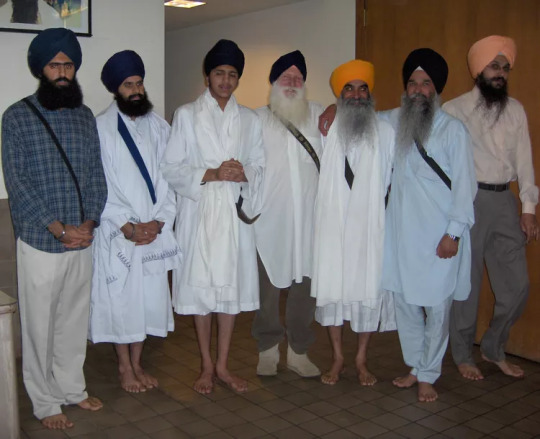
Salvar Kamees - Sikh Women's Wear
Salvar Kamees is Sikh women's wear. Salvars are baggy loose fitting pants with ankle cuffs called ponche. The salvar is worn beneath the kamees, a dress top which is available in as many styles as there is imagination, and colour, often decorated with embroidery. The color of the salvar and kamees may match or contrast. They are worn with a colour coordinated matching or contrasting chunni or dupatta. The very devout tend to wear simple prints or solid colours with a little embroidery, as an expression of humility.
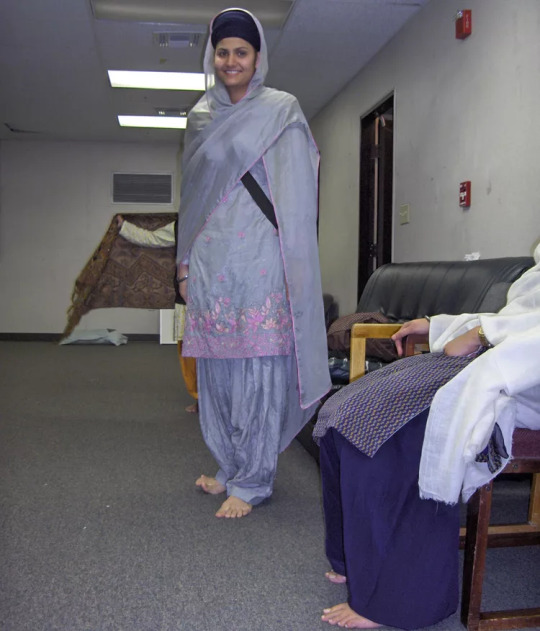
Shastar - Weaponry
In addition to the required kirpan, various types of Shastar weaponry may adorn traditional Khalsa warrior attire. Siri Sahib is a term of respect applied to a sizable kirpan. A chakar is often used to adorn a turban. A gurj is a kind of spiky mace historically used in battle and worn at the waist. A singh might also carry a teer in the form of a ceremonial spear or an arrow.
Turban - Headwear of a Sikh
The Sikh turban is worn in a variety of styles. Required wear for a Sikh man, a turban is optional for a Sikh woman who may choose instead to wear a scarf, alone, or over a turban.
Turban styles:
Domalla - Double length turban of 10 or more yards
Pagri - Double width turban of five to six yards
Dastar - A single turban of four to six yards
Keski - A short turban of two or three yards
Patka - A square of half to one yard tied over the joora (top knot) and head
Fifty - A half yard worn beneath turban
Scarf styles:
Chunni - A sheer lightweight veil of up to two and half yards
Dupatta - A double-wide fabric veil of up to two and half yards
Ramal - Square or triangular head cover
Havard referencing:
Sukhmandir Khalsa. (2018). Introduction to the Traditional Dress of Sikhs. [Online]. LearnReligion. Last Updated: 19 April 2018. Available at: https://www.learnreligions.com/traditional-dress-of-sikhs-2993014 [Accessed 18 September 2023].
0 notes
Note
We have two letters for the "a" sounds, अ and आ.
अ is just an "a" (like uh (?))
आ is for "aa" (like in car)
So often when converting Hindi words to English, we add an "a" to the end. It's not really pronounced
But when westerners pronounce it, they pronounce it with an "aa" sound
Like for example krishna, shiva. the a at the end is not really pronounced, except for an intonation(?) at the end
But in some words, we do pronounce the "a" at the end. like in chola.
This has led to many Hindi words being butchered in english
(idk if i explained it well enough. but i tried. hope it helps a bit?)
Also, the pronunciation of Punjabi. The "u" is supposed to be pronounced with an "a" sound, like in pun. but people mispronounce it so much that I've seen people starting to write it as Panjabi to make it easier for people, when they shouldn't have to. If white people can learn how to pronounce dostoesvsky, they can learn how to pronounce punjabi
oh wow this is really interesting and makes total sense! you did a great job of explaining it!
0 notes
Video
youtube
Sufi Kalam | Darveeshi Shaan Da Chola | Best Sufi Punjabi Status | Sufia...
0 notes
Text
Celebrating Makar Sankranti in India
Every year Makar Sankranti falls on the 14th or 15th of January, and there’s a good reason for that too. The term “Sankranti” refers to the movement of the Sun from one Zodiac to another, so there are a grand total of 12 Sankrantis. What makes Makar Sankranti special? During Makar Sankranti, the Sun moves from Sagittarius or Dhanu Rashi to Capricorn or Makar Rashi, in numerous ways this signifies a new beginning. The Sun which moves into the Northern Hemisphere leads to longer days and the end of the Indian Winter. It falls during the harvest season, with freshly cut crops offered to gods and subsequently eaten. The period signifies “fertility” and bursting into action after the slow and delirious winter season. It ushers in the “auspicious” part of the year which lasts until Karkata Sankranti which falls somewhere in July. It is also the only festival celebrated going by the solar calendar. The contrast between the cozy western holiday season and the vibrant onset of Hindu fertility is an abrupt transition but goes perfectly with the hopeful nature of the new year.
All over India, Makar Sankranti is celebrated in different ways with each one doing their own thing. 14th/15th January signifies not one or two but many festivals.
In Tamil Nadu, the festival is known as Pongal, which translates to “to boil, overflow” and freshly cut rice is cooked with milk and jaggery. The Tamil version can be traced back to the Chola empire, so roughly around the 9th to 13th century. Spread over three days (and a lesser-known fourth day), each day has its own significance. The first day is known as Bhogi Pongal or Indran and focuses on cleaning the house, as each member dusts and scrubs until every surface is squeaky clean. The second day is called Thai Pongal or Surya Pongal and is the most important day, the Pongal is made and first offered to the gods, then the cattle, and only after that are the family members allowed to have it. The third day is spent grooming and worshipping the cattle.
Uttayaran in Gujarat can only be defined by one word, “vibrant”. Strewn across skies are kites that made for a tapestry. There is an industry revolving around this particular time of the year, as kite sales skyrocket (pun intended) and officials from different countries come to participate in kite competitions. The reason behind flying kites is that being out in the Sun after the winter helps kill germs and be more exposed to Vitamin D. Dishes like Undhiyo that are nearing the end of their season are relished for the last time.
If we go farther North, we come across Lohri, the Punjabi variant of Makar Sankranti. The folklore attached to Lohri is of a man known as Dulla Bhat, who lived during the reign of Emperor Akbar. He used to steal from the rich and distribute it among the poor. In his honor, people sing “Sundar Mundriye” during Lohri. This story is different than the religious and godly myths surrounding the other festivals, and it’s fascinating how a festival honors a man who worked for the needy. Punjab is a largely agrarian state, so the festivities are rooted in harvesting crops. People get together around huge bonfires and eat everything from Chikki to Saro ka Saag.
There are tons of other festivals on this day, in Assam it's called Magh Bihu with games like tekeli-bhonga (pot-breaking) and buffalo fighting taking place. In Bihar, locals have chuda-dahi (beaten rice and yogurt) and a portion of gur (jaggery), and in Bengal, it’s called Poush Sankranti and have sweets like pithe, patishapta, etc. with rice and palm jaggery.
- Priyanshu
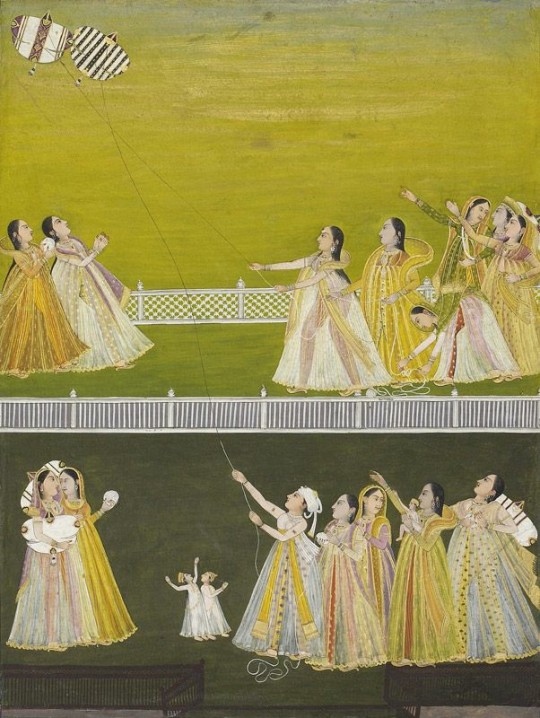
Painting Credits: Ladies on a Terrace Kite-fighting, circa 1775.
#india#indian#indian dark academia#indian aesthetic#aesthetic#dark academia#indian culture#desi#desi dark academia#makar sankranti#kites#kite flying#kite festival#pongal#magh bihu#uttarayan#Gujarat#Assam#Punjab#tamil Nadu#lohri#indian festival#indian festivals#festival#festivals
22 notes
·
View notes
Text
Types of desi Earrings that every Woman should own this festive season
Types of Indian Earrings
Ever wondered why women have a love for Earrings? Earrings are an easy way to enhance your appearance. When you want to dress for any occasion, festival, wedding event, or even a simple pooja, adding statement earrings to your ethnic wear is an easy way to spruce up your appearance. Many different styles of earrings can easily enhance your Indian outfit . We have listed below earring types that every girl/woman should have in their jewelry box.
1. Jhumka’s or Jhumkis
Jhumka’s are a type of earrings worn by women in the Indian subcontinent. The term Jhumki means bell-shaped Earrings. The origin of this earring can be traced back to Chola Dynasty (300 B.C). They have been a traditional favorite and also popular in the modern world due to their style. They can accentuate your ensemble.
We have brought some unique designs for you that you can pair with your outfits without any second thought


2. Danglers or Dangling Earrings
Dangling Earrings are the ones that hang and swing from side to side. They usually dangle below the earlobe. sometimes below the shoulder. They can add a splash of sizzle to your look. They look gorgeous and even show through an open hairdo. They look breathtakingly beautiful with your Saree, desi outfits like Anarkali or Punjabi suits. The Dangling Earrings are grand enough to amplify your look without adding a necklace to your attire.


3. Chandelier Earrings
The Chandelier earrings are similar to Dangling Earrings and hang below the ears. The difference is that the shape becomes broader at the end that resembles the chandelier. They can add oodles of glamour to your outfit and make you stand out from the crowd. This style is more luxurious and elegant. We recommend that you add this to your jewelry trinket and wear it to make a statement with a simple outfit.


4. Drop Earrings
Drop Earrings and Dangler Earrings are often confused and some people believe they are the same. The Drop Earrings and Dangle earrings are similar except that drop earrings are stationery and do not swing side to side. They are statement earrings and are great with chic dresses. They have a distinct stylish design and can make your outfit look more feminine and elegant. These statement earrings are a must-have in your collection


5. Chandbali Earrings
The Chandbali’s have originated during Mughal and Rajput royalty. As the name implies, Chaand is the Moon, Bali’s is Earrings. Many different designs have been created from traditional to modern by many jewelers and designers incorporating Kundan, meenakari, and gemstones. They are still one of the popular earrings and look breathtakingly beautiful with updos and loose hairstyles. You can wear this on any special occasion with your ethnic wear and will surely gather many compliments.

6. Stud Earrings
Stud Earrings are simple and elegant. They are something that every woman needs to have in their trinket box. They are perfect for daily wear outfits and can even glam up your everyday outfit.
So grab your favorite pick this festive season and add this to your jewelry collection.

#bollywoodjewelry#thesparklezbox#maharaniwedding#southasianbridemagazine#earrings#jewelryoftheday#pursuitsofpotraits#weddingnet365#indianfashionblogger#fashion#accessoriesaddict#bollywood
1 note
·
View note
Photo

#Punjabi #Cheekar #Chola https://cook.urdutehzeb.com/showthread.php?612-Punjabi-Cheekar-Chola&p=635#post635 https://www.instagram.com/p/Bssfw8zBSao/?utm_source=ig_tumblr_share&igshid=jcii33v4ls7m
0 notes
Photo

Evergreen Masala Chola! There are many ways in which chola can be prepared and trust me I just love tasting each of it. I generally add poppy seeds to the gravy. It gives a lovely texture and flavor to the gravy. Chola are best had with bhatura. But if you are not in a mood of making bhatura you can make whole wheat flour puris or plain parathas also. They also taste wonderful. Recipe link here!
0 notes
Text
best indian restaurant menu in edmonton - amritsar junction
With the same wonderful experiences and tastes as we grew up eating in India, we bring you the same great Indian cuisine to Edmonton. With our exceptional service, authentic aromas, delicious Indian cuisine, and flavorful, homemade recipes, Amritsar Junction is sure to become your new favorite restaurant in Edmonton. Experience the best Indian Bread in Edmonton today, and see what we have to offer.
Here’s a list of Indian bread:
Roti/Chapati:- While roti (or chapati bread) is the main food in North India, rice is the main food in South India. Roti is a straightforward, unleavened bread made with whole wheat flour and fried on a griddle. It can be served with straightforward dals or unusual curries. Chapati has a wonderful melty edge and is soft and slightly chewy. The word “Chapati” is derived from the Hindi word “Chapat,” which in English means “flat.” For many savory or sweet relishes in India, it makes the ideal side dish. People frequently break the bread and savor the flavor.
Paratha:- This bread was first produced in the Indian subcontinent and has since spread to many other nations. Whole wheat dough is used to make the flat flatbread known as paratha. Unlike Chapati, the bread has a thicker substance. In Tiffin, people frequently eat paratha for breakfast or as a snack (tea-time meal in India). For the bread, locals typically stuff mashed, seasoned potatoes with lentils (dal). You can also utilize vegetables like paneer, cauliflower, or radishes. The bread will taste better if you add butter, pickles, yogurt, or chutney. Additionally, you can roll a paratha and sip tea while eating it.
Naan:- Perhaps the most well-known Indian bread is naan. Although it is wonderful for absorbing up the gravy in curry meals, this fluffy, leavened Indian flatbread is also the appropriate companion for other well-known dishes like paneer, dal, rajma, chicken, and many more. It is best served hot.
Puri:- Puri has a different name for each language because there are numerous variants of India that range from region to region. A golden-brown snack from India, puri is a crispy deep-fried delight. It is a specialty of the Indian subcontinent, made using whole-wheat flour without yeast. Puri is a meal that is used in religious ceremonies like Pooja. For an explosive supper, serve this bread with curries that feature potatoes or other savory dishes like Chana masala or Korma. Halwa or Kheer, two common dessert accompaniments, are made using semolina. In India, Puri is typically served with chole, paneer, curry or bhaji to provide some delicious flavor and aromatic spices. It also has a stunning Indian dessert that is there to sate your appetite, though.
Kulcha:- The most well-known Kulcha variety, with its distinctively delicate and airy texture, is found in Amritsar and Delhi. White peas are used to make the delicious street cuisine known as “Matar Kulcha,” which you must sample when in Delhi. Prepare to be surprised by this gentle Indian flatbread! A champion among Indian leavened flatbreads, kulcha has a subtle, mellow flavor. Before the second kneading, the dough is worked up tight and lifted. The baker will flatten and round it before baking it in the tandoor. Ghee or butter is frequently brushed on top of the bread to moisten the surface and give it a little creaminess.
Bhatura:- Bhatura is an Indian fermented bread that is best savored when paired with Punjabi Chole, a chickpea dish. It is deep-fried to crispy, fluffy, golden-brown perfection. Bhatura is puffed deep-fried bread from India. It is a leavened bread that uses baking powder, commercial yeast, or natural yeast and is mildly fermented. Chola Bhatura is a highly well-liked combo, especially in Delhi, in North India. This combination can be seen on the menus of expensive restaurants, roadside shacks, and even certain street carts. To enjoy Indian food, you must try this dish, which is frequently served with achari aloo (tangy stir-fried potatoes), pickles, and spicy onions.
Amritsar Junction is one of the most popular Indian Restaurants in Edmonton, and for good reason. Our authentic Indian cuisine is served with impeccable service in a warm, welcoming environment. Our chefs prepare each dish with care, using only the finest and freshest ingredients. Our extensive buffet menu offers something for everyone, including vegetarian and vegan options.
0 notes
